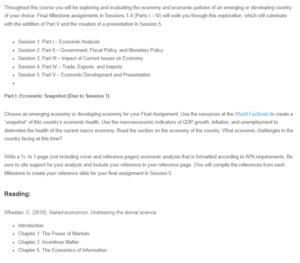Discussion – China’s Economy
China has moved from being a centrally planned, closed system to one that is more market-oriented. Since the 1970s, the country has played a major worldwide role by implementing gradual reforms. The reforms have resulted in efficiency gain that has contributed to a tenfold GDP increase since 1978. The reforms commenced with the phasing out of the collectivized agriculture, which expanded to also include price liberalization, the opening of foreign investment and trade, development of modern banking system and stock markets, private sector growth, increased state enterprise autonomy, and fiscal decentralization. Because of the country’s political factors, the public sector accounts for a larger percentage of the national economy compared to the ever-growing private sector (World Fact Book). In 2018, China was ranked 73rd in GDP and 67th in nominal GDP by the IMF. The country boasts the largest total banking assets in the world, with natural resources estimated at $23 trillion, of which 90% are rare earth metals and coal (Craig, 2016). China is also the global leader in the export of goods and manufacturing economy. The country is also the fastest growing economy in consumer markets as well as the second-largest in the world in goods importation. Further, the country is the global trading leader and has a significant role in international trade (Sims, 2013; Barnett, 2013; Scott &Sam, 2016; WTO, 2017).
GDP Growth, Inflation and Unemployment
China’s labor force as of 2012 was 1.004 billion, and at the end of 2017, the number had dropped to 806.7 million. The unemployment rate reduced by 0.1 % from 2016 to 2017 (4% to 3.9%). The household income by percentage share was 2.1%, the lowest 10%, and 31.4% the highest 10% (2012), while 3.3% of the population lived below the poverty line as of 2016. The rate of inflation dropped from 2% in 2016 to 1.6% in 2017. The real growth rate of GDP increased from 6.7% to 6.9% from 2016 to 2017. Based on these figures, it can be seen that China is experiencing an exponential economic growth rate. Although the GDP improved and those living under the poverty line were a small percentage in comparison to the larger population size, the number of employed persons dropped by a considerable percentage of close to 20%. This means that China faces the threat of having to close or scale down its manufacturing and other business sectors or increase the number of immigrant employees. A high unemployment rate will increase the rate of persons living below the poverty line. The decline in numbers of employed citizens is mainly due to the aging of the working population.
Economic Challenges
The economic challenges that the country faces include the management of a high corporate burden for financial stability maintenance, reduction in high domestic rate and subsequent low domestic household consumption, off-balance sheet control of local government debt used in financing infrastructure stimulus, and slackening the real estate investment sector without slowing the economy sharply. Other challenges include maintaining competitiveness while simultaneously facilitating opportunities for a higher wage for the middle class, including college graduates and rural migrants; reduction of overcapacity in industries; and increasing growth rates of productivity through capital allocation that is more efficient, as well as state support for innovations. The one-child policy that was later relaxed in 2016 has had consequences on China’s economy as it is now the leading aging population in the world. The country’s industrialization has resulted in rural-urban migration, which has, in turn, resulted in the loss of arable land due to urbanization and erosion. Lastly, another long-term problem is the steady decline of the water table, soil erosion, and air pollution, all of which are forms of environmental deterioration (World Fact Book).
References
Barnett, S. (2013). China: Fastest Growing Consumer Market in the World. https://blogs.imf.org/2013/12/02/china-fastest-growing-consumer-market-in-the-world/
Craig, A. (2016). 10 Countries With The Most Natural Resources. https://www.investopedia.com/articles/markets-economy/090516/10-countries-most-natural-resources.asp
Scott, M., &Sam, C., (2016). Here’s How Fast China’s Economy
Is Catching Up to the U.S. https://www.bloomberg.com/graphics/2016-us-vs-china-economy/
Sims, D. (2013). China Widens Lead as World’s Largest Manufacturer. https://www.thomasnet.com/insights/imt/2013/03/14/china-widens-lead-as-worlds-largest-manufacturer
World Fact Book. East Asia/South East Asia: China. https://www.cia.gov/library/publications/resources/the-world-factbook/geos/ch.html
WTO (2017). Trade recovery expected in 2017 and 2018, amid policy uncertainty. https://www.wto.org/english/news_e/pres17_e/pr791_e.htm
ORDER A PLAGIARISM-FREE PAPER HERE
We’ll write everything from scratch
Question

Discussion – China’s Economy
Throughout this course, you will be exploring and evaluating the economy and economic policies of an emerging or developing country of your choice. Final Milestone assignments in Sessions 1-4 (Parts I – IV) will walk you through this exploration, which will culminate with the addition of Part V and the creation of a presentation in Session 5.
- Session 1: Part I – Economic Analysis
- Session 2: Part II – Government, Fiscal Policy, and Monetary Policy
- Session 3: Part III – Impact of Current Issues on the Economy
- Session 4: Part IV – Trade, Exports, and Imports
- Session 5: Part V – Economic Development and Presentation
Part I: Economic Snapshot (Due in Session 1)
Choose an emerging economy or developing economy for your Final Assignment. Use the resources at the World Factbook to create a “snapshot” of this country’s economic health. Use the macroeconomic indicators of GDP growth, inflation, and unemployment to determine the health of the current macroeconomy. Read the section on the country’s economy. What economic challenges is the country facing at this time?
Write a ½- to 1-page (not including cover and reference pages) economic analysis that is formatted according to APA requirements. Be sure to cite support for your analysis and include your reference in your reference page. (You will compile the references from each Milestone to create your reference slide for your final assignment in Session 5.
Reading:
Wheelan, C. (2010). Naked economics: Undressing the dismal science.
- Introduction
- Chapter 1: The Power of Markets
- Chapter 2: Incentives Matter
- Chapter 5: The Economics of Information:

